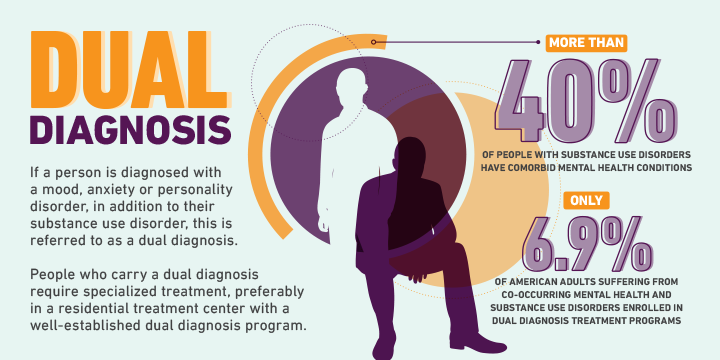Comorbidity : Substance Use Disorders and Other Mental Illnesses
What is comorbidity?
Comorbidity describes two or more disorders or illnesses occurring in the same person. They can occur at the same time or one after the other. Comorbidity also implies interactions between the illnesses that can worsen the course of both.
Is drug addiction a mental illness?
Yes. Addiction changes the brain in fundamental ways, changing a person’s normal needs and desires and replacing them with new priorities connected with seeking and using the drug. This results in compulsive behaviors that weaken the ability to control impulses, despite the negative consequences, and are similar to hallmarks of other mental illnesses.
How common are comorbid substance use disorders and other mental illnesses?
Many people who have a substance use disorder also develop other mental illnesses, just as many people who are diagnosed with mental illness are often diagnosed with a substance use disorder. For example, about half of people who experience a mental illness will also experience a substance use disorder at some point in their lives and vice versa. Few studies have been done on comorbidity in children, but those that have been conducted suggest that youth with substance use disorders also have high rates of co-occurring mental illness, such as depression and anxiety.
Why do these disorders often co-occur?
Although substance use disorders commonly occur with other mental illnesses, this does not mean that one caused the other, even if one appeared first. In fact, establishing which came first or why can be difficult. However, research suggests three possibilities for this common co-occurrence:
- Common risk factors can contribute to both mental illness and substance use disorders. Research suggests that there are many genes that can contribute to the risk of developing both a substance use disorder and a mental illness. For example, some people have a specific gene that can make them at increased risk of mental illness as an adult, if they frequently used marijuana as a child. A gene can also influence how a person responds to a drug – whether or not using the drug makes them feel good. Environmental factors, such as stress or trauma, can cause genetic changes that are passed down through generations and may contribute to the development of mental illnesses or a substance use disorder.
- Mental illnesses can contribute to drug use and substance use disorders. Some mental health conditions have been identified as risk factors for developing a substance use disorder. For example, some research suggests that people with mental illness may use drugs or alcohol as a form of self-medication.Although some drugs may help with mental illness symptoms, sometimes this can also make the symptoms worse. Additionally, when a person develops a mental illness, brain changes may enhance the rewarding effects of substances, predisposing the person to continue using the substance.
- Substance use and addiction can contribute to the development of mental illness. Substance use may change the brain in ways that make a person more likely to develop a mental illness.
How are these comorbid conditions diagnosed and treated?
The high rate of comorbidity between substance use disorders and other mental illnesses calls for a comprehensive approach that identifies and evaluates both. Accordingly, anyone seeking help for either substance use, misuse, or addiction or another mental disorder should be evaluated for both and treated accordingly.
Several behavioral therapies have shown promise for treating comorbid conditions. These approaches can be tailored to patients according to age, the specific drug misused, and other factors. They can be used alone or in combinations with medications. Some effective behavioral therapies for treating comorbid conditions include:
- Cognitive behavioral therapy (CBT) helps to change harmful beliefs and behaviors.
- Dialectical behavioral therapy (DBT) was designed specifically to reduce self-harm behaviors including suicide attempts, thoughts, or urges; cutting; and drug use.
- Assertive community treatment (ACT) emphasizes outreach to the community and an individualized approach to treatment.
- Therapeutic communities (TC) are a common form of long-term residential treatment that focus on the “resocialization” of the person.
- Contingency management (CM) gives vouchers or rewards to people who practice healthy behaviors.
Effective medications exist for treating opioid, alcohol, and nicotine addiction and for alleviating the symptoms of many other mental disorders, yet most have not been well studied in comorbid populations. Some medications may benefit multiple problems. For example, bupropion is approved for treating both depression (Wellbutrin®) and nicotine dependence (Zyban®). More research is needed, however, to better understand how these medications work, particularly when combined in patients with comorbidities.
Points to Remember
- Comorbidity describes two or more conditions appearing in a person. The conditions can occur at the same time or one right after the other.
- Comorbid substance use disorder and mental illnesses are common, with about half of people who have one condition also having the other.
- Substance use disorders and mental illnesses have many of the same risk factors. Additionally, having a mental illness may predispose someone to develop a substance use disorder and vice versa.
- Treatment for comorbid illnesses should focus on both mental illness and substance use disorders together, rather than one or the other.
- Effective behavioral treatments and medication exist to treat mental illnesses and addiction.


